Hundreds of species of beetles are native to North America’s regions or the entire continent. Black and red beetles are some of the most contrasting beetles that tend to stand out immediately.
The red and black combination makes these beetles appear poisonous. Some of these beetles might be toxic and many have a foul taste that predators hate as a confirmation of their looks.
Black and red beetles spread across multiple species such as lady beetles and weevils. These can be red and black only or they can come in a red and black morph.
The color of the beetles has little impact on the diet of these bugs. Some red and black beetles are herbivorous while others are carnivorous and true predators.
A smaller percentage of these beetles even show cannibalistic behavior, especially among larvae.
The specific role of black and red beetles in the ecosystem depends on each species. Some are beneficial, as is the case of the black and red beetles that eat aphids and scale insects.
Other black and red beetles can be seen as mild or serious pests, as is the case of palm-boring beetles which kill trees from their larval stage.
The following species of black and red beetles are the most common. Some of them are beneficial while others are detrimental to the environment or even seen as major pests.
Table of Contents
1. Asian Lady Beetle

The Asian Lady Beetle (Harmonia axyridis) is the most common black and red beetle. This species has red elytra and up to 22 black spots.
Some Asian Lady Beetles do have not black spots at all. However, most beetles of this genus are known for their black spots.
Asian Lady Beetles are known predators despite their friendly look. They feed on aphids and scale insects which means they have a beneficial role in the ecosystem.
Asian Lady Beetles are among the most common biological control agents among all black and red beetles. They are introduced in North American and European crops to control invasive aphids and scale insects.
2. Seven-spotted Lady Beetle

Similar to the Asian Lady Beetle, the Seven-spotted Lady Beetle (Coccinella septempunctata) also has red elytra with black spots. This species has 7 total spots which inspire its name.
Beetles of this group have varying sizing from 7.6mm to more than 12mm. Despite its small size, the species keep many predators away through its colorful red and black body which makes it appear toxic.
Common in North America and Europe, the Seven-spotted Lady beetle is a species used in the control of aphids on crops.
Seven-spotted Lady Beetles also eat other invasive species that can be problematic on crops or in greenhouses. These alternative species include thrips and whiteflies.
Seven-spotted Lady Beetles are also seen consuming the larvae of plant lice.
3. Convergent Lady Beetle

Convergent Lady Beetles (Hippodamia convergens) have similar red elytra with black spots and a black and white head.
Unlike the similar Asian Lady Beetle and the Seven-spotted Lady Beetle, the Convergent Lady Beetle is mostly found in North America, partly in South America, but not in Europe.
This North American species has a similar diet to the Asian Lady Beetle which consist of aphids.
Active through the summer, these beetles are also known for high reproductive rates with hundreds of eggs laid by the female before wintertime when the species overwinters.
4. Red Milkweed Beetle
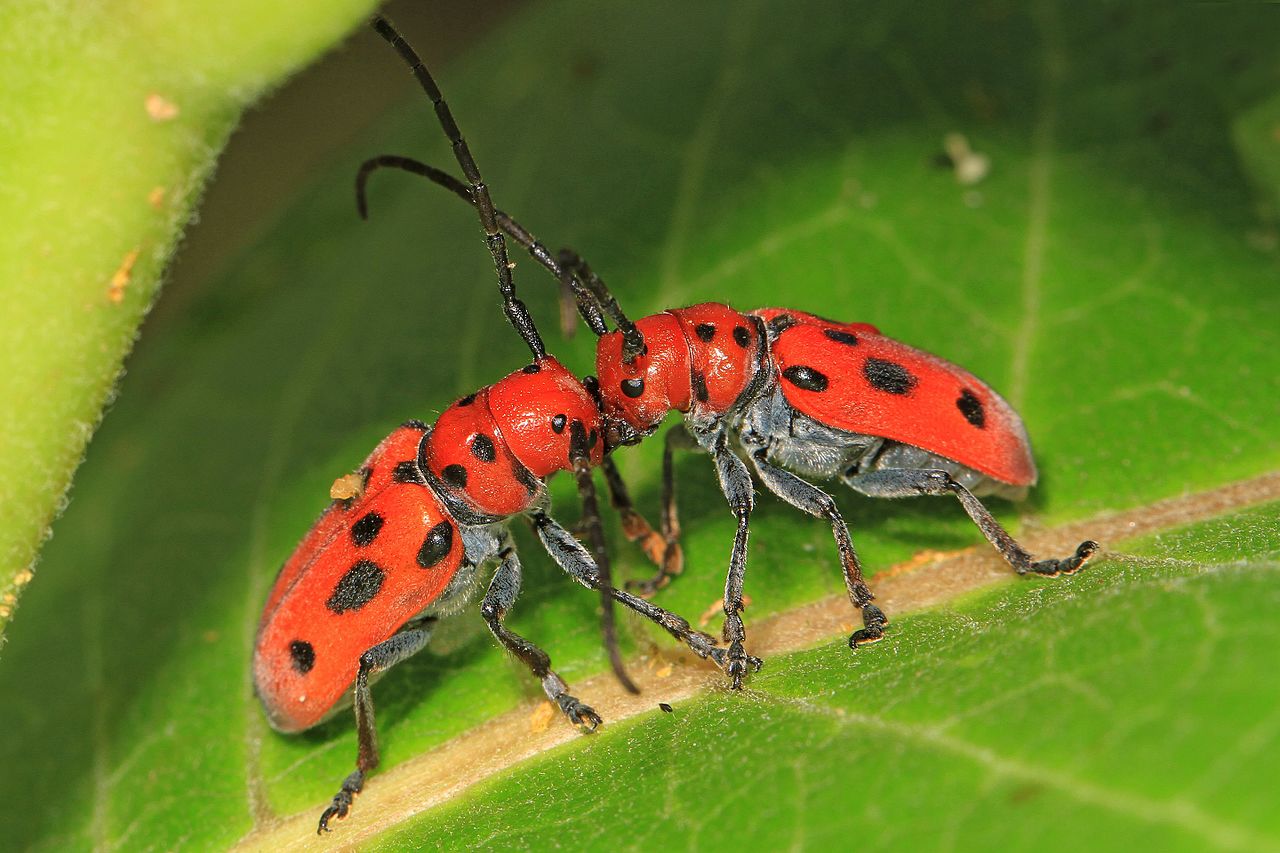
The Red Milkweed Beetle (Tetraopes tetrophthalmus) is among the most common plant-eating black and red beetles in North America.
This species doesn’t eat aphids or scale insects as it prefers aphids.
Red Milkweed Beetles have an elongated red body with black spots. They can be seen on milkweed.
Beetles of this genus feed directly from the veins of the plant.
Plant sap is consumed as food by the species.
Defensive measures involve absorbing toxins for a bad taste as well as making noise. These beetles make a low-key noise when in the presence of predators.
5. Spotted Pink Ladybeetle

Lady beetles of the Spotted Pink Ladybeetle (Coleomegilla maculata) genus can have a base red, pink, or orange color with black spots on the elytra and the head.
This oblong shape ladybeetle is among the species that is both carnivore and omnivore, depending on its location, weather, or personal feeding preferences.
In some parts of North America, the Spotted Pink Ladybeetle considers pollen as almost half of its food intake.
The species also feed on aphids, adelgids, and the larvae of various plant mites.
A varied diet makes the species a very common sight on various crops these pest insects live.
Peas and soybean crops together with alfalfa crops are the most common areas where you can find high numbers of Spotted Pink Ladybeetles in North America.
6. Twice-stabbed Lady Beetle

Native to North America, the Twice-stabbed Lady Beetle (Chilocorus stigma) has a black base color.
This species has 2 large red spots on each side of its elytra.
Unlike other lady beetles, this species is highly common in woodlands. It also lives in gardens on various citrus plants.
Its presence is signaled in pine woodlands and other types of woodlands where it feeds on invasive species.
Pine needle scales and other types of scales in woodlands comprise the bulk of its diet.
The species has few natural enemies. Heavy use of pesticides in orchards is considered the biggest threat to this lady beetle.
7. Red-femured Milkweed Borer

This elongated red beetle with tiny black spots across the head and elytra is among the most common species in North America.
Its name is inspired by its host plant, milkweed. This plant feeds both its larvae and the adults of the species.
The larvae of the Red-femured Milkweed Borer (Tetraopes femoratus) feed on the finer roots of milkweed. Adults feed on the plant itself for sap which may eventually kill the plant.
One of the reasons this species eats milkweed is to absorb toxins to have a bitter taste to all of its potential predators such as birds.
8. Shiny Flea Beetle
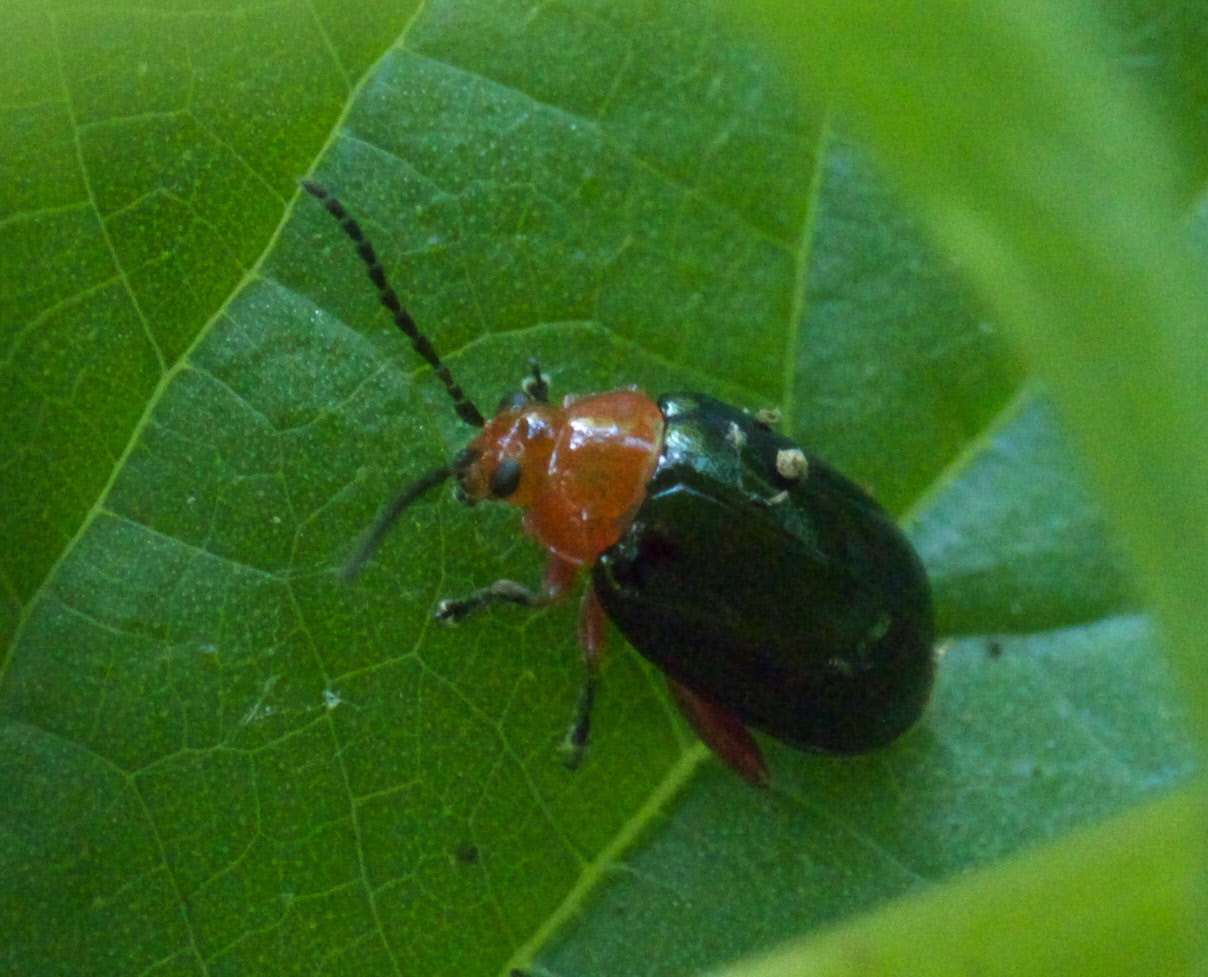
Similar to cockroaches with an oval shape, Shiny Flea Beetles (Asphaera lustrans) have a red prothorax and black elytra.
This species grows up to 10mm with some variation of its colors such as brown and black or orange and black morph.
Native to North America, the species also has a widespread presence in Central America.
Most Shiny Flea Beetles that feed on plants are found in Southern parts of the US.
These bugs are found in places such as Southern Texas and Southern parts of Arizona.
9. Cactus Lady Beetle

Cactus Lady Beetles (Chilocorus cacti) get their name from the cacti they inhabit in Southern parts of the US. This species of beetle has mostly black coloring with a red central band and long black bristle-like hairs.
The species feeds on species scale insects as well as on the larvae of scale insects.
Its highest presence is noted around prickly pear cacti as well as around coconut palms.
Cactus Lady Beetles has been one of the possible species used to control scale insects.
Results are mixed even in countries where the species has been introduced in high numbers compared to other predatory species such as the Asian Lady Beetle.
10. Cocklebur Weevil

Cocklebur Weevils (Rhodobaenus quinquepunctatus) are a species with a rusty red color with black spots and large black sections.
Its legs and antennae are also black.
As its name implies, the Cocklebur Weevil feeds on cocklebur. It also feeds on ragweed and other sunflower-group plants.
However, the species doesn’t feed on actual sunflowers as much as on ragweed and cocklebur.
Weevils of this species are sometimes seen in a different aspect based on orange or brown coloring.
All of the morphs of this weevil have the specific long black elongated snouts which serve for easier feeding.
11. Macrosiagon limbata

This species has both black and red coloring in similar amounts across its body. Its wings are black while its prothorax and its underside are red.
Its legs are black and red.
Unlike other black and red beetles, this specie isn’t a predator as it mostly feeds on plants.
Goldenrod and elderberries are the preferred nectar sources of bugs.
Only seen during the summer months, Macrosiagon limbata beetles prefer to live in open areas rich in flowers.
Low vegetation allows the species to easily navigate between wildflowers for nectar.
12. Eurasian Red-and-black Melyrid
Eurasian Red-and-black Melyrid beetles (Anthocomus equestris) have an elongated body shape with a narrower section next to the head.
This species has red wings with large black marks, a black head, and black legs.
It’s believed this species only feeds on plants even if the larvae are also believed to be carnivorous.
The Eurasian Red-and-black Melyrid might only be present on crops by accident as it prefers wildflowers in open areas.
Bugs of this genus can accidentally make it indoors but without being seen as a pest as they are only attracted to artificial light.
13. Two-spotted Lady Beetle
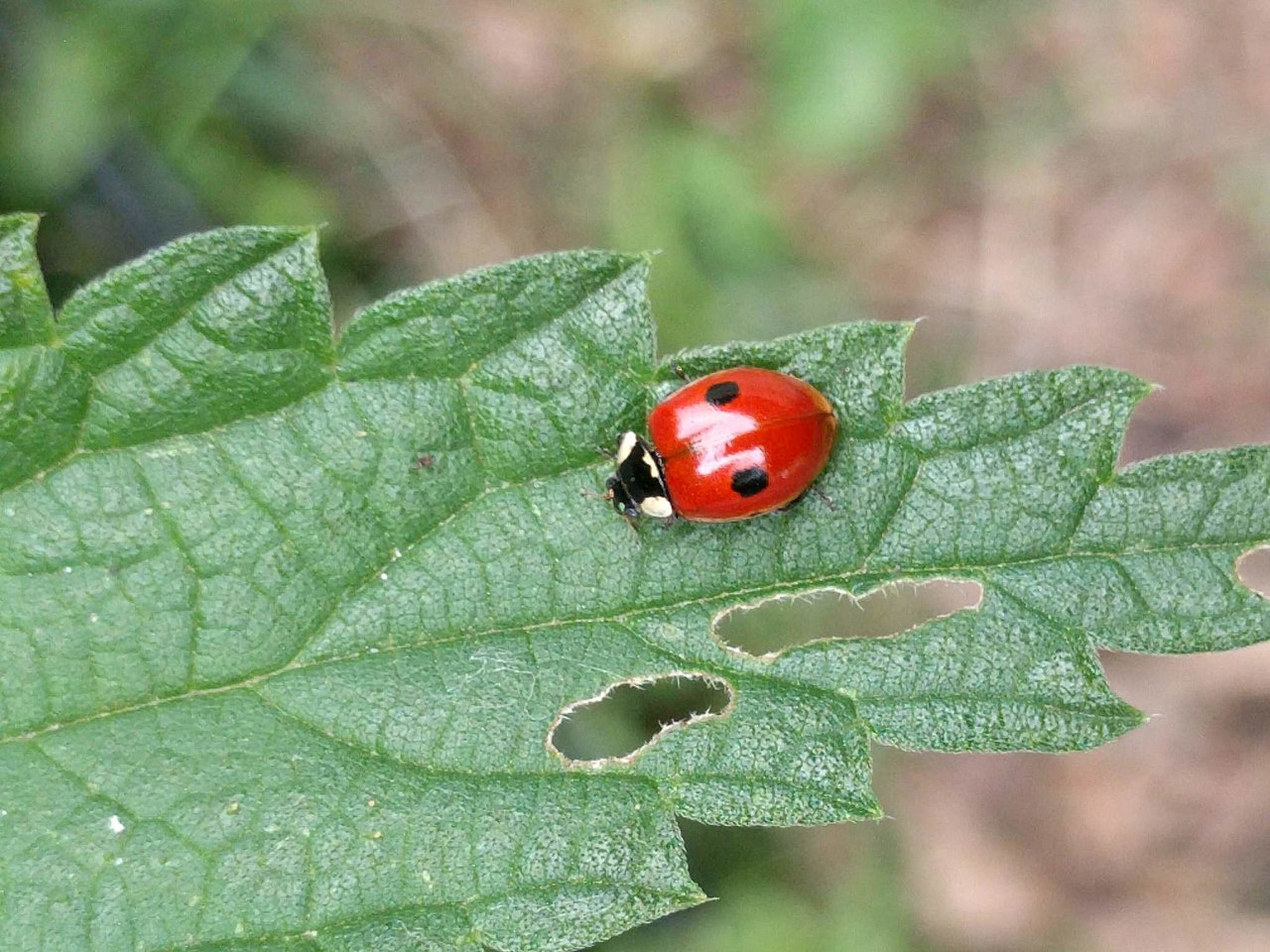
Two-spotted Lady Beetles (Adalia bipunctata) have red elytra with just 2 black spots. Its head is black with 2 white spots.
This species is known for eating aphids and other scale insects. It’s successfully used in controlling aphid populations.
The larvae of the Two-spotted Lady Beetle are cannibalistic as it eats other larvae of the same species.
Beetles of this genus tend to change colors from larvae to adulthood completely.
Brown and black are the main colors of the Two-spotted Lady Beetle as opposed to the red and black of the adults.
14. California Glowworm
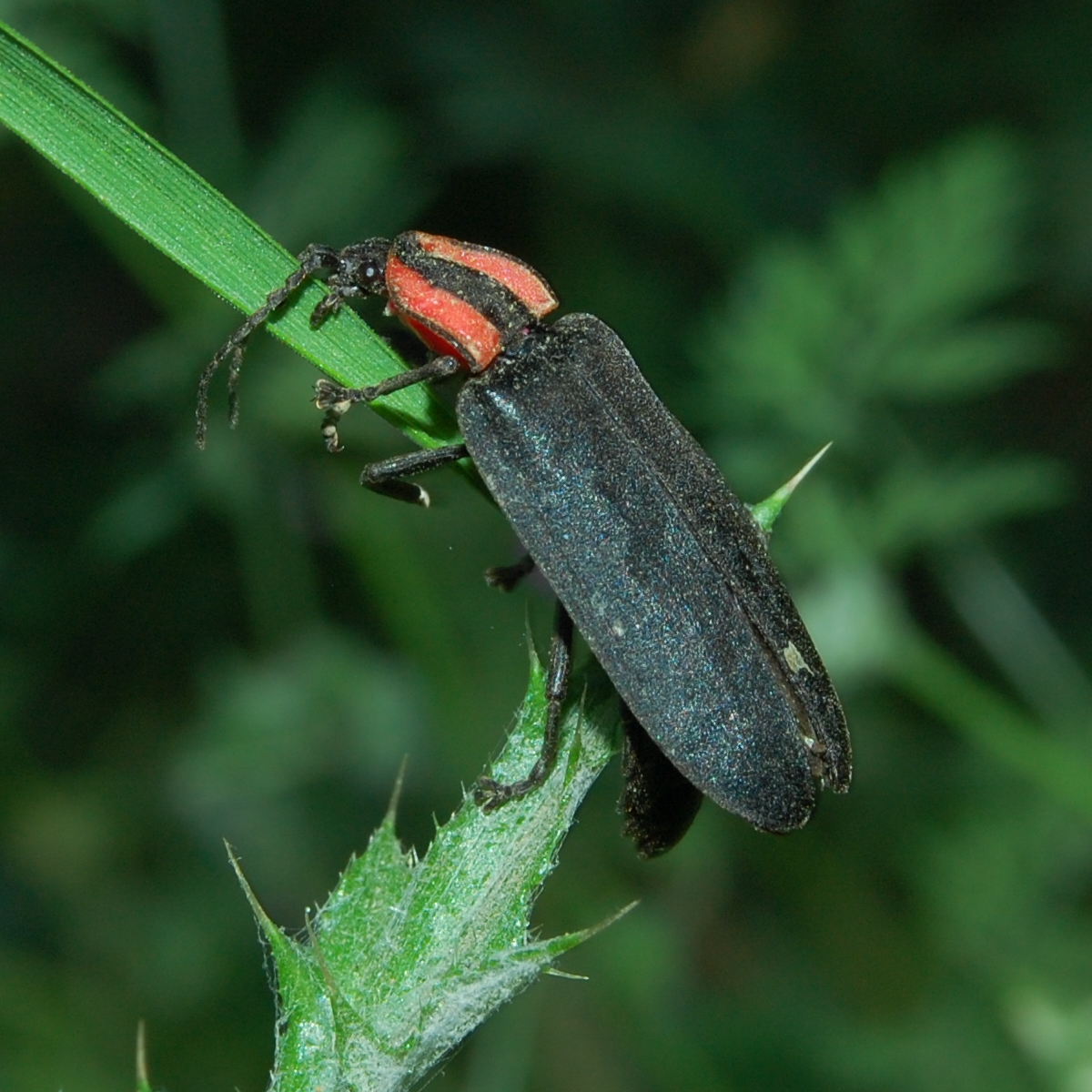
This species of glowworm (Ellychnia californica) is a rare sight in California as most seek out its glowing abdomen which is only specific to the larvae of the species.
The luminescence of the California Glowworm larvae is what makes this species distinct.
Adults have no light-producing capacity and they are known for only being black and red.
The elytra of the species are black, as are its legs. The head of the adult California Glowworm is red.
The species is known for having an external digestive system. It injects saliva which decomposes food so they can suck it up instead of chewing the food.
15. Three-banded Lady Beetle

Native to states on the Pacific Coast, the Three-banded Lady Beetle (Coccinella trifasciata) is among the species with a high impact when it comes to aphid control.
A known predator, the Three-banded Lady Beetle is one of the multiple native species that eat aphids. Furthermore, the species also consume large amounts of pollen.
You can identify this lady beetle by its dome-shaped red elytra. Black bands are seen across its elytra.
The species also has a black and white head.
Unlike other red lady beetles, the Three-banded Lady Beetle stands out with its black bands instead of black spots or dots.
16. Colorado Soldier Beetle

Colorado Soldier Beetles (Chauliognathus basalis) are a species of red and black Solider Beetles. These types of beetles are known for living in pairs or small groups, as opposed to living on their own as other black and red beetles.
An elongated shape is specific to the body of the species. Red to orange base color with large black spots make the species stand out.
Its head has a similar red coloring with tiny black spots.
Some morphs of this Solider beetle are yellow while others can be orange.
Yellow asters are the preferred pollen source for the Colorado Solider Beetle.
17. Ironweed Curculio

This species of Curculio (Rhodobaenus tredecimpunctatus) is seen on ironweed, its host wildflower species.
It feeds with its elongated black snout.
You can identify this species by its red body with tiny black spots. Up to 4 black spots are seen on each side of the elytra with 5 spots specific to its prothorax.
The legs and antennae of the species are all-black and not black and red as multiple similar species.
18. Red-shouldered Pine Borer

Red-shouldered Pine Borers (Stictoleptura canadensis) are some of the longest-living black and red beetles of the species.
These pine borers can live multiple years in US and Canadian territories.
Black is the main color of the elytra while the head is mostly red.
Red-shouldered Pine Borer larvae feed on decaying wood or decaying plant matter.
Adults eat living plants but they can have a different diet depending on the part of the plant they eat.
Some pine borers eat tree bark while others only eat leaves or blossoms.
A smaller range of Red-shouldered Pine Borers found in woodlands and next to woodlands may also eat fungi.
19. Scarlet Malachite Beetle

Scarlet Malachite Beetles (Malachius aeneus) are native to Europe. Introduced in North America, it’s now a widespread species.
Some of the areas with large cereal crops are known for being the perfect habitat for this species. You can identify this species by its oval-shaped black body with a lower red abdomen.
The Scarlet Malachite Beetle is a predator and it rarely feeds on pollen or cereals themselves.
This species feeds on the Common Pollen Beetle, a smaller black beetle that exclusively feeds on pollen.
Scarlet Malachite Beetles remain the most common in Northern parts of Europe.
20. Transverse Lady Beetle

Transverse Lady Beetles (Coccinella transversoguttata) have a base red color with black spots and black marks.
Red is the main color of the elytra with 4 black spots and a long black band located behind the black head.
Lady beetles of this genus feed on aphids.
As a result, they have a widespread habitat from woodlands to open areas and crops.
These beetles are often seen in parks and gardens where they can eat aphids that feed on various types of trees or vegetables.
Aphids are also found in high numbers next to water sources. This is the main reason these lady birds are also often seen next to lakes and rivers.
21. Passionflower Flea Beetle
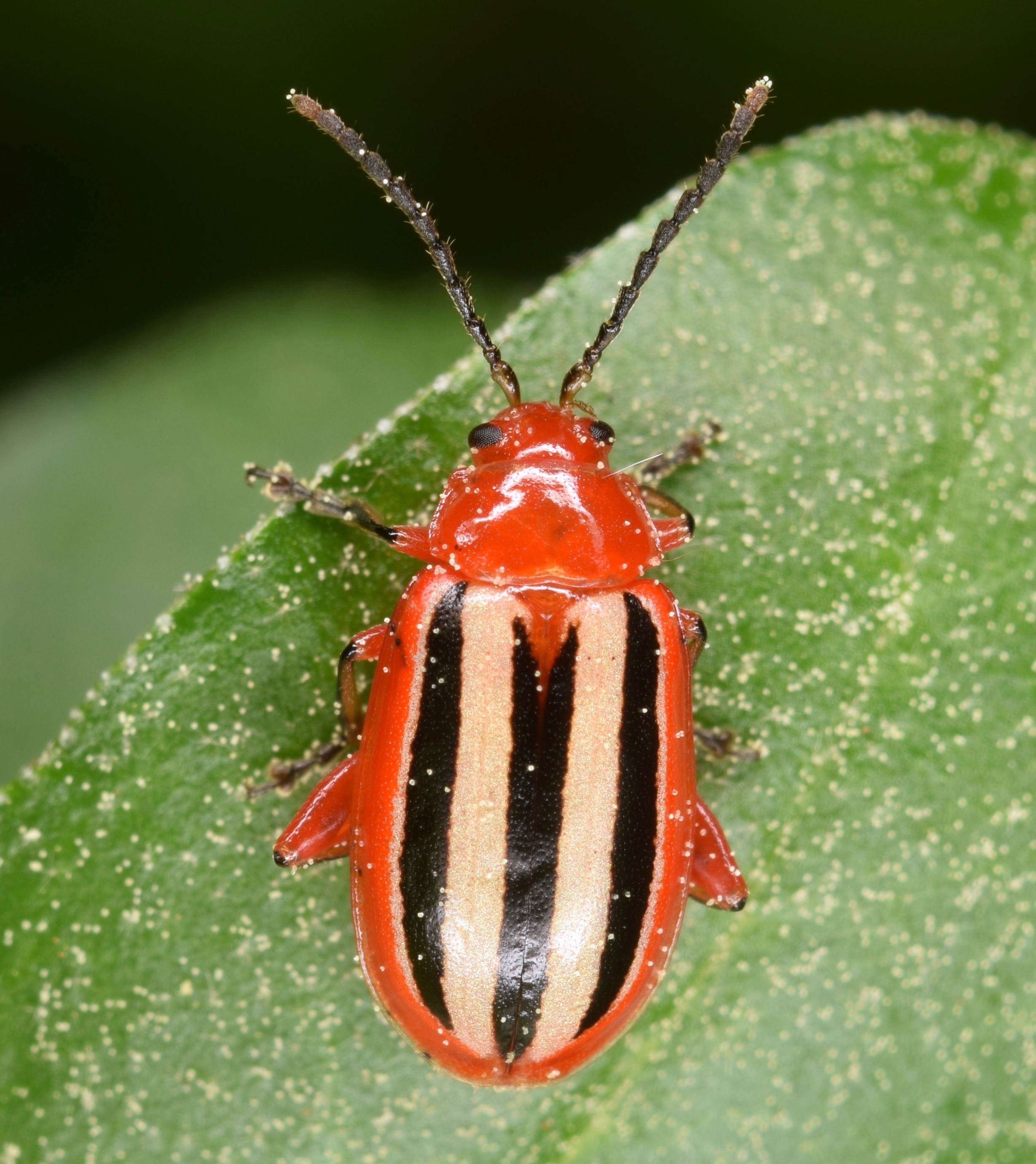
Passionflower Flea Beetle (Disonycha discoidea) is a North American native species.
It grows to a length of up to 10mm and it stands out with its red and black body.
This species feeds on passionflowers and it’s easily distinguished on these colorful flowers given red is its main color.
However, the Passionflower Flea Beetle is also seen in other colors. It can have black and white elytra as opposed to all-black elytra.
Some rare morphs of the species don’t have any red coloring at all. These morphs have a brown or tan base color with black as the secondary color of the elytra.
This species is only seen on meadows for a short period as it has one of the shortest fly seasons of all red and black lay beetles in North America.
The Passionflower Flea Beetle appears in May and it’s only active until early July.
22. Seaside Lady Beetle

Seaside Lady Beetles (Naemia seriata) are named after their preferred coastal habitats. This species is among the most common ones on beaches and all terrains next to the coast such as bay areas.
You can find the Seaside Lady Beetle both on the Western and Eastern North American coasts.
This species has a base red color which can sometimes be pink or pale orange. Black spots are further visible on its elytra and its head.
These black spots have irregular shapes and tend to be connected on the sides of the elytra and disconnected on the central section of the elytra.
A least a couple of sub-species of the Seaside Lady Beetle exist. Its subspecies can live further out from the ocean but still within reaching distance of the coastline.
23. Twice-struck Lady Beetle

The Twice-struck Lady Beetle (Axion plagiatum) is a native North American species. It’s also native to The Caribbean.
This species is common in 2 morphs. Its base color combination is black and red. Black elytra with 2 red spots are characteristic of the Twice-struck Lady Beetle as its name implies.
A rare morph of the species combines a black base color with 2 light brown marks.
Both morphs have dome-shaped elytra with a small head that’s also black.
Twice-struck Lady Beetles are most common in Southwestern parts of the US. This species is only adapted to living in warm climates with its black and brown morph more likely to be seen further North.
24. Red-blue Checkered Beetle

The Red-blue Checkered Beetle (Trichodes nuttalli) is a common species on multiple types of flowers rich in pollen.
Lady beetles of this family feed on pollen themselves but they can also feed on some of the smaller pollinator insects they find on these flowers.
A common sight on yellow flowers, the Red-blue Checkered Beetle can consume bees and other insects that land on the flower for pollen.
The larvae of this species are more likely to consume these insects while adults are more likely to eat pollen.
Red-blue Checkered Beetles have a base black color with interrupted red bands across the body and with a black head.
Some members of the species have a black base color with interrupted orange bands. A rare black and yellow morph of the species has also been spotted.
The size of all of these morphs is small as these lady beetles mostly grow to a maximum length of 10mm.
25. Palmetto Weevil

Palmetto Weevils (Rhynchophorus cruentatus) are some of the most damaging palmetto tree weevils. These weevils are known to kill palms in a way that can rarely be prevented as the damages are only visible when considerable.
The species has a black and red body as an adult.
The adult weevil has a black body with red vertical stripes and wide red sections on a black head.
It lays eggs on the base of palm branches. These eggs turn into grubs which start to dig into the tree.
These grubs are highly efficient at digging into the palm and they eventually multiply and eat the tree until they kill it.
These grubs are seen as some of the most damaging larvae in the world of palms.
Palmetto Weevil grubs are consumed as a delicacy rich in protein outside North America.
26. Handsome Fungus Beetle

Handsome Fungus Beetles (Endomychus biguttatus) are also red and black. A red elytra is specific to this species.
The red color of the Handsome Fungus Beetle is darker than the vivid red color of other beetles. Black tiny spots decorate the elytra of the species.
Black is the sole color of the prothorax of the Handsome Fungus Beetle.
Further black sections are seen on the legs and the antennae.
This species likes to eat fungi and it’s present in areas of high humidity around the house as well as in woodlands.
While not a true pest threat, the Handsome Fungus Beetle can also make it indoors in homes with high humidity when fungi grow.
27. Oak Leafrolling Weevil

Oak Leafrolling Weevils (Synolabus bipustulatus) are a small round species that are mostly black.
The sides of the species show 2 large red sections. These weevils have black heads, black legs, and black antennae.
Another morph of the Oak Leafrolling Weevil has brown spots instead of red spots on its body.
This species is known for laying eggs directly on the leaves of oak trees which it rolls for protection.
28. Blackened Milkweed Beetle

The Blackened Milkweed Beetle (Tetraopes melanurus) is part of a group known for having very long antennae.
This species has red base coloring which may sometimes be orange, brown, tan, or yellow.
Its red base color is the widespread color of the species.
Large black marks are distinguishable on the species. Its lower wings are black while tiny black spots are further visible on its head.
29. Red-shouldered Leaf Beetle
This species (Saxinis saucia) is a rare type of red and black beetle specific to the Southwestern parts of the US.
It has a distinct shiny round black body with 2 red spots on the sides. Sometimes confused with Milkweed Beetles, this species tends to be different in the brighter red areas along its body.
Red-shouldered Leaf Beetles are some of the smallest leaf beetles in North America. They grow to a maximum length between 4 and 6mm.
30. Variable Ladybird Beetle
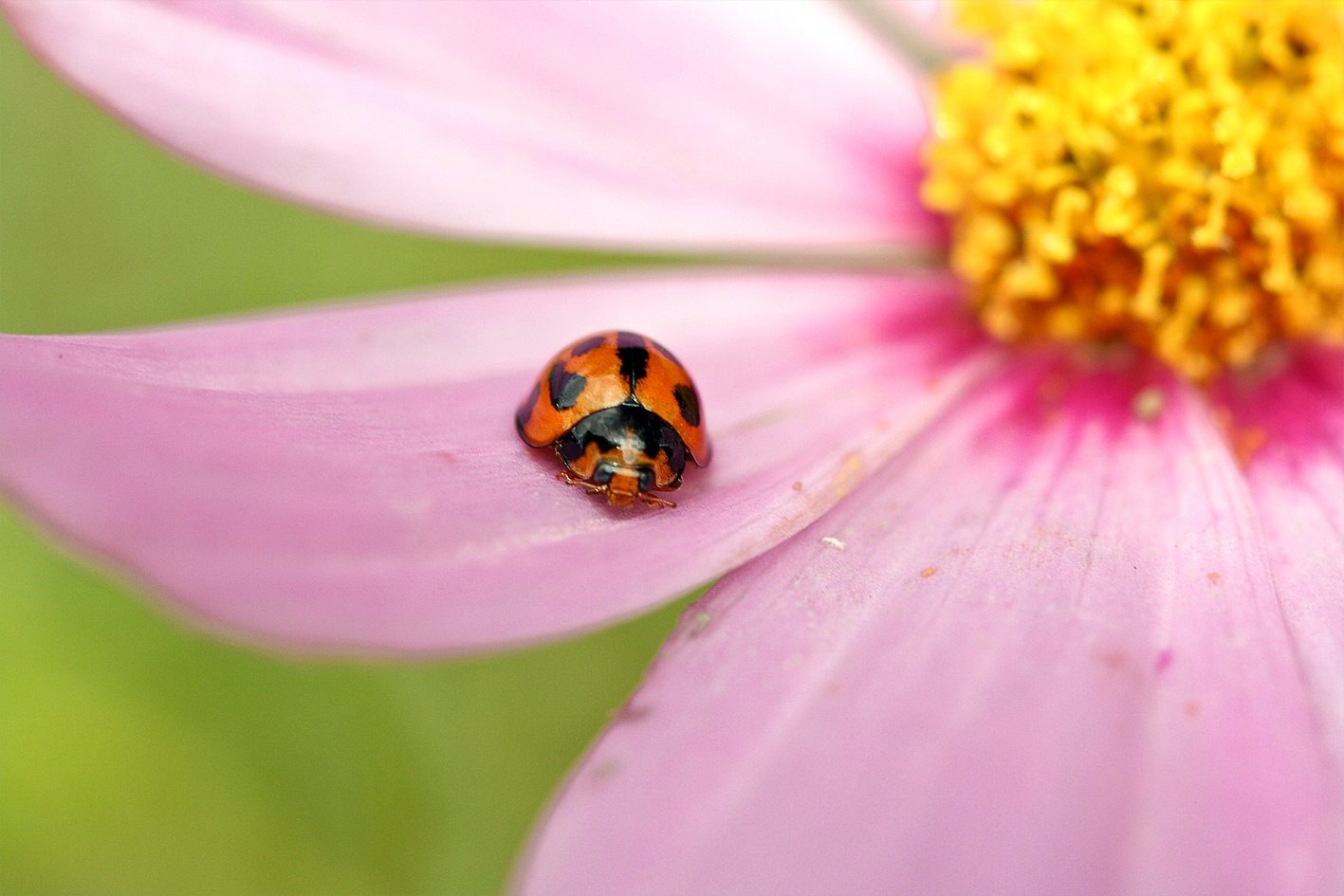
The dome-shaped small Variable Ladybird Beetle (Coelophora inaequalis) is one of the smallest red and black predators.
This species is native to Australia and it has been introduced around the world for its successful attempts to control aphid populations.
Variable Ladybird Beetles are known to prefer the sugarcane aphid the most. Therefore, it’s a common sight in sugarcane-rich areas as a biological control agent.
This species has a black base color with red marks. It also comes in yellow color with black marks.
31. Four-spotted Collops

Known for having a similar size of up to 6mm as the Red-shouldered Leaf Beetle, the Four-spotted Collops (Collops quadrimaculatus) has a dark red base color.
This color contrasts the 4 large spots across its wings and the small black spot on its red head.
Four-spotted Collops are most common in the extreme South of the US with a widespread presence further South into Central America.
The Four-spotted Collops are most common in Arizona and New Mexico.
32. Slender Lizard Beetle

Slender Lizard Beetles (Acropteroxys gracilis) get their name from their slender bodies that measure up to 12mm.
These North American native beetles have a mostly black color with red marks on the sides of their elongated head.
Beetles of the Slender Lizard genus are a common sight on the Common Ragweed which is a host plant.
These beetles are considered a pest of secondary plants. Alfalfa and red clover are among the most impacted secondary plants by this species.
Slender Lizard Beetles feed on alfalfa and red clover.
Other flowers impacted by the species outside crops include various species of asters.
33. Lined Buprestid Beetle

Lined Buprestid Beetles (Buprestis lineata) are a rare native species of dark red and black beetles.
They are only native to Southwestern US territories and The Caribbean outside of the country.
You can identify this species by its stripes body. Its wings show vertical dark red to brown stripes and black alternating stripes.
Further differentiating factors for the species include a golden head which may sometimes be all-black.
34. Blackened Blister Beetle

The Blackened Blister Beetle (Epicauta atrata) is one of the largest native pest beetles.
This species grows up to a length of 17mm and it stands out with its striped body alongside its size.
A black body with yellow stripes that feature red margins is visible on the wings of the species.
This beetle has striped forewings and transparent hindwings.
Blackened Blister Beetles cause minimum damage to alfalfa, bean, and carrot crops among others.
35. Say’s Burying Beetle

Say’s Burying Beetle (Nicrophorus sayi) is a native species to Southern Canada and parts of the US such as Illinois.
This beetle has a contrasting black and red look with transparent hindwings.
Its body has a shiny black color, a black head, black legs, and black antennae.
4 red marks are further distinguished on the species. Small red marks are also seen on the tips of its antennae.
Say’s Burying Beetles lay their eggs directly in dead animals as other species of Nicrophorous beetles.
36. Spinach Flea Beetle

Spinach Flea Beetles (Disonycha xanthomelas) are native to North and Central America.
These beetles are very small and similar to most other flea beetles in terms of size.
A black body is specific to the species, mostly across the elytra (forewings). This species has a red head with a black spot and a red underside.
The Spinach Flea Beetle feeds on entire leaves except the veins.
They eat multiple types of weeds to the extent they can kill plants. Feeding on multiple weeds, the species has been introduced as a natural weed control agent with mixed results.
Spinach and all of the related plants are a common food source for these beetles.
Beets are among the most common alternative host plants outside of spinach for the Spinach Flea Beetle.